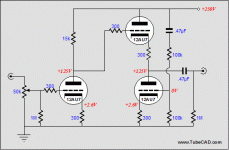May be a stupid question, but in JB's Aikido calculations:
http://www.tubecad.com/2004/blog0013.htm
Rk=(Ra-rp)/(mu + 1)
what's Ra?
I can't find a definition of Ra in JB's pages or in RDH4, and even more confusing is that TDSL uses Ra synonymously with rp. Argh!
http://www.tubecad.com/2004/blog0013.htm
Rk=(Ra-rp)/(mu + 1)
what's Ra?
I can't find a definition of Ra in JB's pages or in RDH4, and even more confusing is that TDSL uses Ra synonymously with rp. Argh!
SY said:It's the plate resistor.
Thanks. I guess that means that equation isn't true for the pentode version of Aikido then? For his 6AU6 schematic, he uses Ra=20K & Rk=150. The datasheet says mu=36 and rp=500K, so the equation doesn't balance (?).
I haven't given the pentode one a thorough lookover, but the equations for the triode will definitely not be applicable.
leadbelly said:May be a stupid question, but in JB's Aikido calculations:
what's Ra?
I thought Ra was the Sun God !
I must be making a basic mistake with this equation, as well.
It occurred to me that a 6AV11 compactron is nothing more than one-and-a-half 12AU7 triode sections in one bottle. Using the three-triode-section circuit shown in Broskie's blog (http://www.tubecad.com/2004/blog0013.htm), I decided to put together a spud aikido preamp.
Plugging in the numbers, I get:
Ra = (17+1) 300+7700 = 144,000
Rk = (144,000-7700)/(17+1) = 7,572
This value is just about half the 15K specified in the schematic.
Where am I going wrong?
It occurred to me that a 6AV11 compactron is nothing more than one-and-a-half 12AU7 triode sections in one bottle. Using the three-triode-section circuit shown in Broskie's blog (http://www.tubecad.com/2004/blog0013.htm), I decided to put together a spud aikido preamp.
Plugging in the numbers, I get:
Ra = (17+1) 300+7700 = 144,000
Rk = (144,000-7700)/(17+1) = 7,572
This value is just about half the 15K specified in the schematic.
Where am I going wrong?
Attachments
Ra=(mu + 1)Rk+rp
15000=(17+1)300+rp
15000=5400+rp
rp=9600
which seems about right, considering that the triode has an unbypassed cathode resistor. It's also running at less plate current than the 10.5mA needed to get down to the 7.7k ohms that you quote.
I don't see a problem with the formula, or results - other than the sloppy use of "Ra" and "rp" in the same argument. All actual resistances use a capitolized R. Impedances use a lower case r, followed by an apostrophe . So, the plate resistance should be written ra', or rp', depending on your preference regarding the terms "plate" or "anode". But one should at least be consistant within the same formula!
Joel
15000=(17+1)300+rp
15000=5400+rp
rp=9600
which seems about right, considering that the triode has an unbypassed cathode resistor. It's also running at less plate current than the 10.5mA needed to get down to the 7.7k ohms that you quote.
I don't see a problem with the formula, or results - other than the sloppy use of "Ra" and "rp" in the same argument. All actual resistances use a capitolized R. Impedances use a lower case r, followed by an apostrophe . So, the plate resistance should be written ra', or rp', depending on your preference regarding the terms "plate" or "anode". But one should at least be consistant within the same formula!
Joel
Thanks for the clarification!
Note to self: have another cup of coffee and engage left brain before attempting simple 8th-grade math.
Now, to get that spud preamp assembled...
Note to self: have another cup of coffee and engage left brain before attempting simple 8th-grade math.
Now, to get that spud preamp assembled...
After reading the equation correctly { Ra= (mu+1) Rk+rp , NOT Ra= (mu+1)(Rk+rp) }, I came up with 13.1K for the plate resistor, and 300 ohms for the cathode.
A quick-and-dirty lash-up with a 250v power supply sounds pretty darn good! I now need to find another three-section compactron for the output stage, and turn this into a full-fledged amplifier.
Thanks again for getting me back on track.
A quick-and-dirty lash-up with a 250v power supply sounds pretty darn good! I now need to find another three-section compactron for the output stage, and turn this into a full-fledged amplifier.
Thanks again for getting me back on track.
Nomenclature's tricky...
Agreed, lower case for small-signal parameters like ra or vin. But following it with an apostrophe means that you've done something to modify it (usually feedback). As an example, you might start with a conventional common cathode amplifier and talk about ra. Then, you might remove the cathode bypass capacitor (allowing feedback) and to distinguish the new value of dynamic anode resistance, you'd call it ra' rather than ra.
Joel said:Impedances use a lower case r, followed by an apostrophe. So, the plate resistance should be written ra', or rp', depending on your preference regarding the terms "plate" or "anode". But one should at least be consistent within the same formula!
Agreed, lower case for small-signal parameters like ra or vin. But following it with an apostrophe means that you've done something to modify it (usually feedback). As an example, you might start with a conventional common cathode amplifier and talk about ra. Then, you might remove the cathode bypass capacitor (allowing feedback) and to distinguish the new value of dynamic anode resistance, you'd call it ra' rather than ra.
SY said:For heavens' sake, it's ra. Subscript tags rule.
Only when I've worked out how to bludgeon them onto the Internet. Alright, I can now see how to do it (from the quote), but it wasn't obvious.
- Status
- Not open for further replies.
- Home
- Amplifiers
- Tubes / Valves
- What's Ra?
